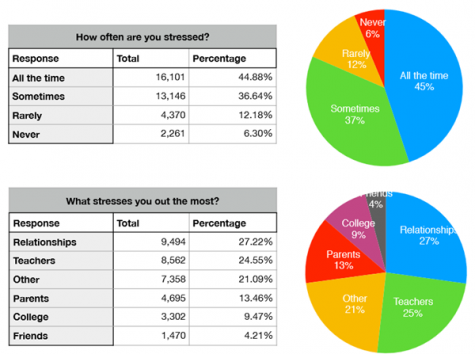Teachers vs. Students: Stress
December 3, 2018
As students file into the school building, chatting with their friends, they all have different thoughts running through their minds. Some of them are excited to start the day and they smile as they enter the doors. Encouraged by the challenges ahead and the opportunity to be with their classmates, these students look forward to the next few hours. However, for other students, this isn’t the case. They approach the building with apprehension about their upcoming test or the worksheet they forgot to do or bring. Their excitement for the school day is slowly being replaced by dread; these are the students who have the path paved for low self-esteem or worse.
With tests, clubs, presentations, and other challenges, it’s no secret that school is one of the most stressful environments for students today. The effect this stress has on students’ minds must be considered
There are two major types of stress: Eustress and Distress. School, with its many facets, can give students both these types of stress. For some, the thrill of learning is positive and challenging in an intriguing way, but for others, the stress of assignments is a boulder on their shoulders. This infographic very clearly illustrates eustress, distress, and their effects on mental health.
The Teachers’ Take
Teachers at South Forsyth seem to agree that stress levels at school are soaring. An interview with Coach Wagner, a health teacher, highlights the different kinds of stress students here encounter.

Teacher input on student stress. Coach Wagner talks about how much weight is on students’ shoulders. He has been teaching about eustress and distress as a part of his curriculum for years. “Distress has become so common in students, it’s a conversation starter nowadays,” Wagner explains.
- Q: How would you define Eustress and Distress?
- A: They have very similar definitions, but with two major differences: Eustress is positive, and beneficial to your health. Distress is negative and harmful to your health.
- Q: Which of these stresses do you think students get on a daily basis?
- A: Distress, definitely. I feel like a lot of people don’t even know that there is a positive form of stress. Distress has become so common, it’s become a conversation starter like “Hey I did so bad on this test” or “This is going to be so hard, I’m going to fail” and things like that. And I think the increased pressure of high grades, school, A.P. classes, that we kind of put on you guys too can definitely cause distress.
- Q: How do these have an impact on the mental health of students?
- A: I think it has a huge impact! A lot of times, we think that stress and anxiety is a normal part of life, which in a way they are, but there are a lot of ways we can limit that. If we don’t practice stress management techniques, then the stress is going to continue to build and build until it can almost be physically sickening. Stress is going to come and go and be a normal part of life, but if the distress isn’t combated with positive stress management techniques instead of negative coping mechanisms, then it’s going to cause a lot of problems. Some examples are insecurities and depression, especially long-term, drawn-out bouts of depression versus just bad days.
- Q: How can students better change the distress into eustress?
- A: Part of that just takes knowledge and knowing what Eustress is. If they don’t know what it is or how to put themselves into situations where they can create it, it’s never going to happen. They’ve also got to make some life changes. If they have a history of procrastinating and not being attentive in class, then they’ve got to muster up discipline. A positive outlook would help too. Research shows that a positive outlook results in a healthier person and an overall better well-being.
- Q: How can teachers better change the distress into eustress?
- A: I think teachers just need to be a little bit more realistic. Oftentimes, we treat students like our class is the only one they’re taking, and so we pile on the work. I think that we need to be knowledgeable as well, and stay up-to-date on the research. If the research shows that repetition is helpful in making students learn but homework doesn’t have an impact, then we have to make sure we practice more topics over and over again in class rather than send students home with a lot to do. This causes them to come back to school more stressed and unable to focus in class. We should lighten the workload, but not necessarily make it easy. Students need to be challenged but in a realistic way. We should try to have meaningful activities, instead of assignments just to put grades in.
The following articles also provide two teachers’ first-person accounts as they saw student stress:
- https://www.linkedin.com/pulse/students-dont-need-from-schools-too-lets-figure-teach-lou
- https://www.middleweb.com/36860/students-are-stressed-and-teachers-can-help/
The Students’ Side

Thousands of statistics for how stressed out students are can be found by a simple google search. Globe News Wire conducted a stress survey in 2018 with over a thousand teens in the U.S. Almost half of the teens surveyed say they’re stressed “All the time,” which is an indication that something is amiss. The second graph better illustrates WHY the teens are stressed. The reasons vary, but relationships, teachers, and college can be found to be in the top- and all of these are things teens encounter every day in school. An NYU study did extensive research into the world of students stress and they concluded that school work, college applications, extracurricular activities, and parental expectations all contribute to teenagers’ stress.
Medha Prasad-Mediratta, a senior at South Forsyth, says that school provides a little more distress for her just because of the homework. However, she says that group projects specifically give her Eustress because of the collaborative feeling.
“Distress can cause me to have a lack of social interaction, anger management issues, and just not being happy,” Prasad-Mediratta explains.
Solutions
The solutions to this problem range from easily implementable in everyday life to a major mindset change. Coach Wagner gives many examples of how teachers can lower student stress without changing the challenge level. In his Health course, he implements these examples throughout his lessons. Instead of having a test at the end of each unit, he has a wide variety of other summative options. In some units, students may have to explain their topic to the class, present a slideshow, or make a plan illustrating what they’ve learned. These application-based assignments cause less stress because students don’t have to constantly cram for a test, and push the focus on understanding material instead.
Students can also lower their stress by simply being more optimistic. While that sounds easier said than done, once achieved, this mindset greatly lowers anxiety. Treating tests like challenges to do better instead of daunting tasks can make all the difference in performance. This will change the distress and fear into eustress and motivation.
Stress will be an integral part of life, no matter what. However, as students, we sometimes have the opportunity to change that stress into something positive. They can work with teachers to make an environment that is full of anticipation, but for the better. And for all those days where the distress takes over, there are always healthy coping mechanisms to deal with it:
